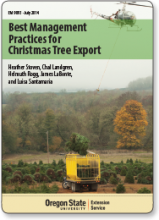Needle midge traps consist of a box with a jar inserted into the top edge of one side. As adults emerge from the soil, they fly towards the light (jar) to escape. Place a moist towel inside the jar to catch the adult midges. The jar will contain other flying and crawling insects, so use a hand lens to help with identification.
See the section on Douglas-fir needle midge for suggestions on the design and timing of traps.
Pay particular attention to Douglas-fir fields that had Douglas-fir needle midge problems the previous year and to edge rows close to native Douglas-fir timber. Needle midges seem to prefer the “shady side” of trees, where there may be some vegetation; however, in a fully stocked field, this could be anywhere. The needle midge is one of the few pests for which there are degree-day models to track emergence, which can vary by 4 to 5 weeks from year to year (Appendix E). The degree-day models can help determine when to place traps. Placing five emergence traps per field of trees is good for monitoring a growing area. Place the traps with the jar side facing between rows so it gets as much light as possible. Check the traps frequently and count needle midges to get an idea of population numbers. Prolonged cool rain during emergence also helps control numbers.
